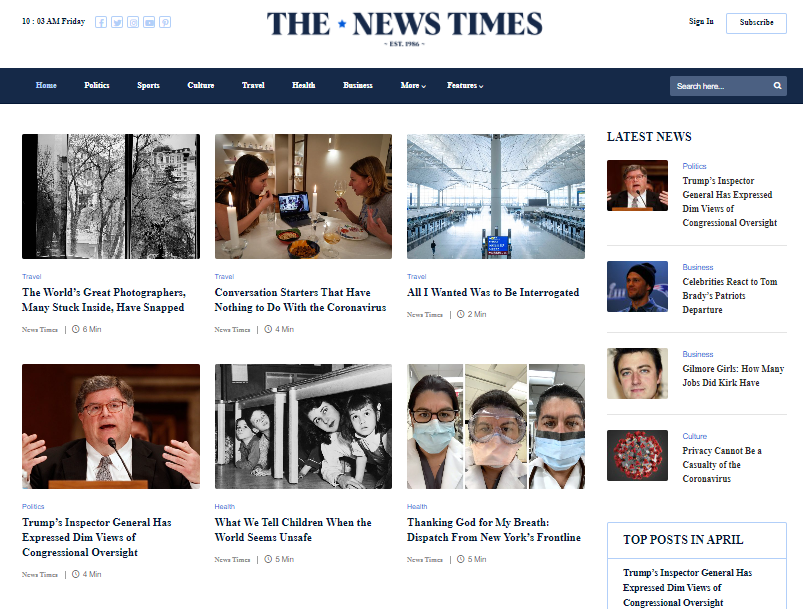Behind the Scenes at How stnews.live Publishes News
Checking out the Future of Journalism: What's Next for News Online?
The future of journalism is developing rapidly in the electronic landscape. Typical approaches are being challenged by new technologies and changing target market habits. Social network, expert system, and interactive narration are reshaping how details is shared and consumed. As newsrooms adjust, they deal with vital questions about trust fund and values. What techniques will emerge to guarantee integrity among these modifications? The answers can redefine journalism as we comprehend it.
The Influence of Social Network on News Consumption
As social media platforms proceed to develop, they have actually essentially changed news consumption patterns. Generally, audiences count on newspapers and tv for info; nonetheless, the increase of systems like Twitter, Facebook, and Instagram has changed this dynamic - stnews.live. News is now easily accessible in real-time, with users obtaining updates straight through their feeds. This immediacy permits quick dissemination of info yet typically at the expenditure of extensive fact-checking
Additionally, algorithms curate material based on individual choices, causing the sensation of echo chambers, where individuals are subjected mainly to point of views that straighten with their own. This can impede essential involvement with diverse point of views. Furthermore, the interactivity of social media allows individuals to get involved in conversations and share content, additionally affecting public discussion. The function of traditional journalism is evolving, necessitating adjustment to preserve credibility and significance in a progressively digital landscape.
The Role of Expert System in Journalism
While the assimilation of expert system (AI) into journalism presents amazing possibilities, it likewise raises substantial concerns about the future of news production and consumption (stnews.live). AI modern technologies can enhance process by automating regular jobs such as data evaluation, fact-checking, and even content generation. This can improve efficiency and permit journalists to concentrate on even more complex narration elements. Concerns regarding precision and predisposition emerge as algorithms might inadvertently continue false information or reflect the prejudices of their creators.
In addition, making use of AI in personalizing news feeds can lead to resemble chambers, where viewers are only revealed to perspectives that strengthen their present beliefs - stnews.live. Honest factors to consider are paramount, especially pertaining to transparency in AI-generated material and the duty of wire service in using these tools. As AI remains to advance, its role in journalism will certainly demand recurring discussion concerning the effects for reputation, responsibility, and the general credibility of news

Innovations in Storytelling and Multimedia Coverage
The landscape of journalism is being changed by technologies in storytelling and multimedia reporting. Interactive storytelling methods engage target markets in brand-new means, permitting them to take part in narratives, while virtual reality journalism involves visitors in experiences that standard layouts can not reproduce. These improvements not only enhance target market interaction however also redefine just how news exists and consumed.
Interactive Narration Methods
Innovative interactive storytelling techniques are transforming the landscape of journalism, engaging target markets in means typical stories can not. These techniques include multimedia aspects such as videos, infographics, and interactive maps, permitting readers to discover stories dynamically. By empowering target markets to browse and customize their experience, reporters produce much deeper connections with their web content. Interactive quizzes and studies additionally enhance interaction, motivating participation and comments. Additionally, social media sites combination makes it possible for real-time discussions, cultivating a community around the tale. Considerably, these strategies not only draw in focus however additionally facilitate understanding of intricate issues, making journalism extra easily accessible. As wire service accept these technologies, the capacity for immersive narration remains to expand, shaping the future of exactly how details is provided and consumed.
Online Fact Journalism
As wire service progressively embrace digital reality (VR) innovation, journalism is getting in a brand-new period of immersive storytelling that mesmerizes audiences like never previously. Virtual reality journalism permits audiences to enter the story, experiencing events from a first-person point of view. This cutting-edge approach improves psychological involvement, as users can essentially browse situation zones, witness historic minutes, or explore complex social problems. By integrating typical coverage with 360-degree video clip and interactive elements, VR journalism promotes much deeper understanding and empathy. Difficulties continue to be, consisting of ease of access, production prices, and the requirement for ethical guidelines. As the technology evolves, it assures to reshape just how news is eaten, pushing the borders of story and redefining the partnership in between reporters and their audiences.
The Altering Landscape of Newsrooms
While conventional newsrooms as soon as acted as the backbone of journalism, they now face significant alteration as a result of technical improvements and moving audience choices. The increase of digital media has actually resulted in the decline of print journalism, prompting news companies to adapt their structures and operations. Lots of have changed to hybrid versions, incorporating on the internet platforms with typical reporting methods to get to more comprehensive audiences.
This change has additionally affected staffing, as newsrooms progressively work with data experts, social media sites strategists, and multimedia reporters to diversify web content and enhance involvement. Furthermore, the emphasis on rate and content manufacturing has actually resulted in the execution of ingenious technologies, such as fabricated intelligence, to simplify procedures.
As a result, the landscape of newsrooms currently shows an extra collaborative setting, motivating cross-functional groups to work with each other in delivering timely and relevant newspaper article. This evolution indicates a crucial duration for journalism as it looks for to browse the complexities of a digital-first world.
Target market Interaction and the New Characteristics of Trust
Audience interaction has actually come to be vital in developing trust fund within the evolving landscape of journalism. By utilizing interactive narration techniques and executing openness and responsibility procedures, wire service can foster a more trusted relationship with their audience. These strategies are important for adapting to the new dynamics of depend on that specify contemporary media usage.
Structure Rely On Journalism
Count on journalism has ended up being progressively vulnerable in a period controlled by false information and rapid technological advancements. As audiences encounter an overwhelming amount of details, critical credible resources check it out has actually come to be a challenge. Reporters and news companies are currently forced to prioritize transparency and reliability to reclaim audience confidence. This consists of giving clear sourcing, fact-checking procedures, and freely dealing with errors. Engaging audiences straight via social media sites and area forums fosters a feeling of involvement and accountability. In addition, media literacy initiatives are essential, outfitting the public with devices to critically assess news material. Eventually, rebuilding trust fund needs a collective initiative from reporters, companies, and audiences alike, making certain that high quality journalism dominates in the middle of visit the site the noise of electronic media.
Interactive Storytelling Methods
The evolving landscape of journalism needs cutting-edge strategies to engage target markets and reinforce trust fund. Interactive storytelling methods have become an effective tool for wire service, enabling them to existing information in vibrant and immersive ways. By integrating multimedia components such as videos, infographics, and interactive maps, reporters can create engaging narratives that encourage energetic involvement from readers. This interaction cultivates a deeper connection to the web content, enhancing the general customer experience. Additionally, interactive storytelling can promote customized material delivery, dealing with varied target market interests and preferences. As journalists accept these strategies, they not only mesmerize target markets yet also add to an extra educated public, inevitably strengthening the count on in between news companies and their visitors in a significantly digital age.
Openness and Accountability Procedures

The Future of Ethical Journalism in the Digital Age
Integrity stays a cornerstone of journalism, especially as the electronic age changes the landscape home of details circulation. In this progressing environment, honest journalism encounters unmatched obstacles and opportunities. The proliferation of false information and the rapid spread of unverified news demand a renewed commitment to precision, justness, and transparency. Journalists have to navigate the complexities of social networks systems, where the line between reporting and point of view typically obscures.

Moreover, the increase of fabricated intelligence in content development raises honest inquiries concerning authorship and liability. As target markets increasingly require reliability, media companies are entrusted with enhancing their moral criteria to keep public trust fund. Joint initiatives amongst reporters, modern technology firms, and regulatory bodies will certainly be essential in crafting guidelines that prioritize ethical practices. Ultimately, the future of ethical journalism hinges on a cumulative feedback to these obstacles, guaranteeing that stability stays at the center of news coverage in the electronic age.
Frequently Asked Concerns
Exactly How Do News Organizations Monetize Online Journalism Properly?
News organizations effectively monetize on the internet journalism with diverse methods, consisting of registration versions, targeted advertising, sponsored content, and partnerships. These methods enable them to generate income while maintaining journalistic integrity and engaging their audience efficiently.
What Abilities Are Essential for Future Journalists in the Digital Age?
Future reporters should cultivate electronic literacy, multimedia narration, information analysis, and social media sites efficiency. Adaptability and critical reasoning are important, allowing them to navigate progressing modern technologies and audience preferences in a significantly complex media landscape.
Exactly How Will Journalism Adapt to Transforming Target Market Demographics?
Journalism will adjust to changing target market demographics by embracing varied web content formats, leveraging data analytics for targeted storytelling, and cultivating area engagement via interactive systems. These methods intend to improve significance and ease of access for evolving readerships.
What Role Do Citizen Journalists Play in the Future of News?
Person reporters are significantly crucial fit news narratives, giving diverse point of views and prompt coverage. Their contributions test typical media, fostering a much more comprehensive details landscape, while also elevating concerns regarding accuracy and liability in coverage.

Exactly How Can Small News Outlets Compete With Larger Media Companies Online?
Little news outlets can complete with larger media business on the internet by focusing on specific niche markets, developing strong community connections, leveraging social networks for interaction, and delivering distinct, local content that reverberates with their audience's specific interests.